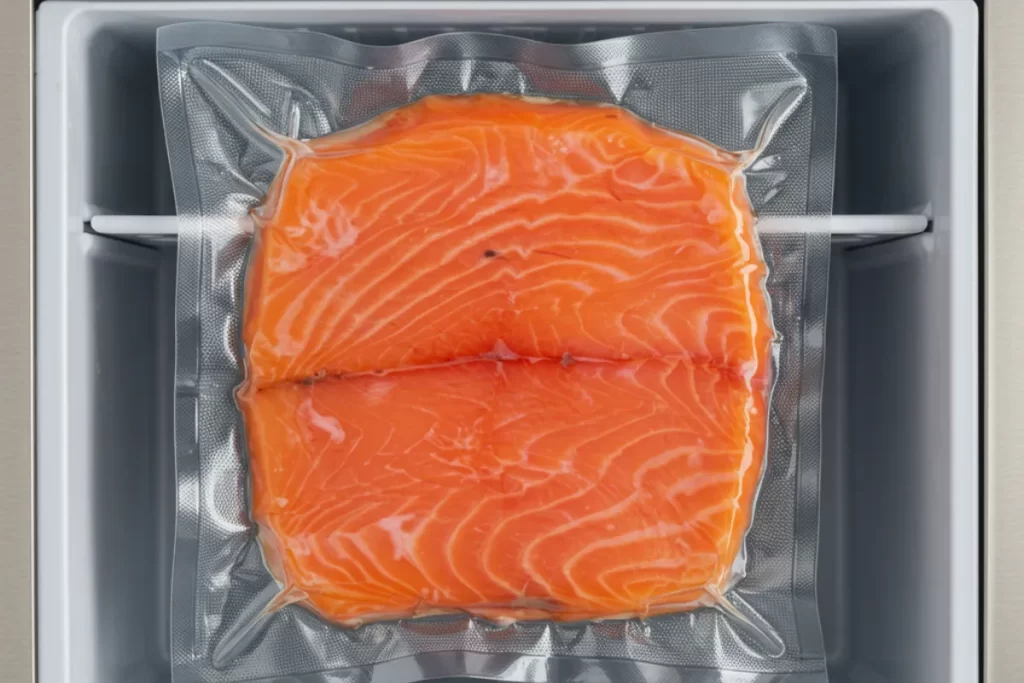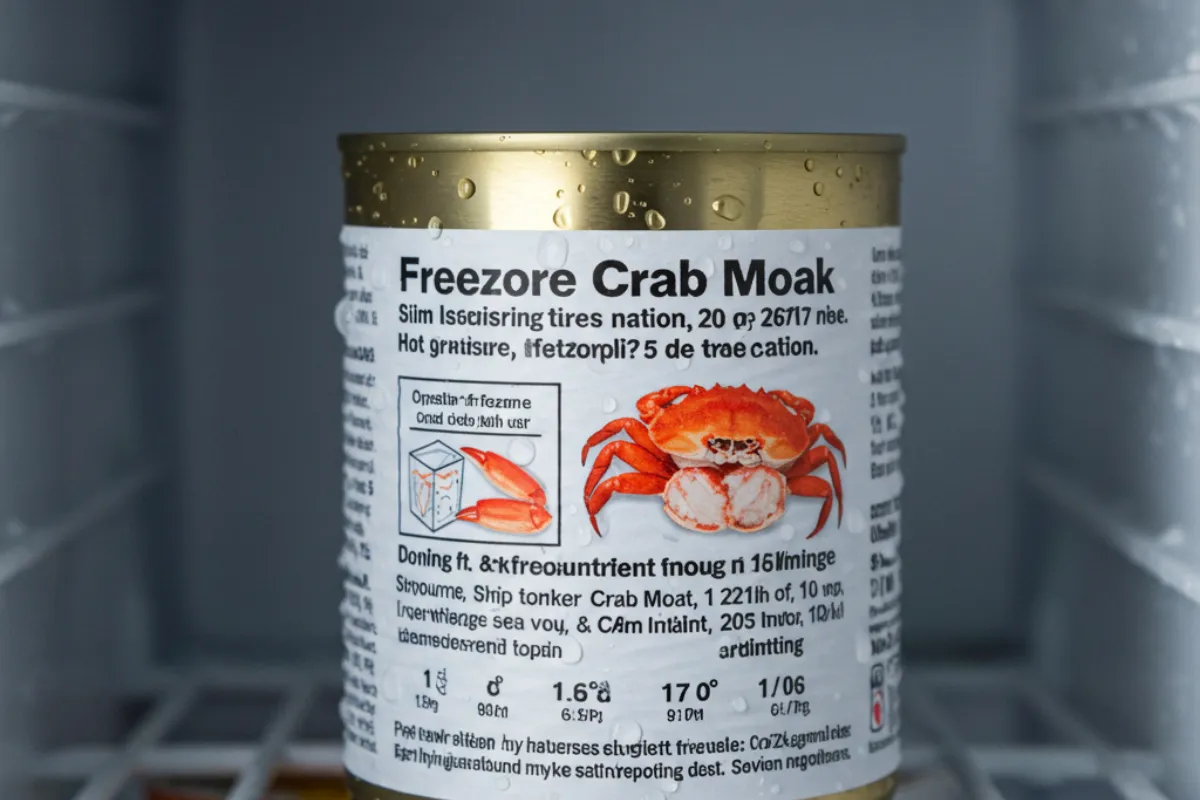Table of Contents
Lox is a popular and flavorful type of salmon that many people enjoy. Whether in a bagel breakfast or a favoured appetizer, it’s a treat for seafood lovers. But what if you have extra lox that you want to store for later? Can you freeze lox? How do you do it without compromising its taste or texture?
This article will answer these questions. It will explain how Lox differs from other smoked salmon. It will also guide you on the best ways to freeze, store, and thaw lox. Let’s dive into all the details about freezing lox and preserving its fresh flavour.
What is Lox?
Lox is a special type of salmon that has been salt-cured but not smoked. The curing process usually involves rubbing the fish with salt and sometimes sugar. Then, it is left to sit for a time. This process gives lox its rich, salty flavour and helps preserve the fish. Lox is typically fattier, especially belly lox, and has a smooth texture.
While lox is similar to smoked salmon in some ways, it’s important to note the differences. Smoked salmon is smoked again, giving it a smoky flavour. This makes smoked salmon more complex in flavour than lox’s simpler, saltier taste.
Now that we know what lox is, let’s move on to the big question: Can you freeze it?
Can You Freeze Lox?

Yes, you can freeze lox! It’s a great way to extend its shelf life, especially if you’ve bought too much or want to store it for later. Freezing preserves the fish and prevents spoilage, allowing you to enjoy your lox later.
However, just like with any fish, freezing can affect the texture and flavour of lox. Freezing may slightly change the texture and make the fish less firm, especially if not packaged properly. But don’t worry! With the right methods, you can freeze lox. It will keep its delicious flavour and texture.
How to Freeze Lox: Step-by-Step Guide

Here are the best practices when freezing lox to ensure it stays fresh and high-quality.
1. Portion the Lox
Before you freeze lox, portion it into smaller, manageable pieces. This way, you can thaw only what you need instead of defrosting the entire batch. If you have whole sides of salmon, consider cutting them into smaller portions for your meals.
2. Wrap the Lox Tightly
Proper wrapping is crucial for preserving lox in the freezer. Wrap the lox tightly in plastic or aluminium foil to avoid freezer burn. Ensure the wrapping is as tight as possible to prevent air from getting in. Freezer burn can dry out the fish and cause it to lose flavour, so proper sealing is key.
3. Use Airtight Containers or Vacuum-Sealed Bags
Place the wrapped lox into airtight containers or vacuum-sealed bags for extra protection. These containers protect the lox from air, moisture, and freezer odours. They keep the fish fresh. If using freezer bags, squeeze out as much air as possible before sealing.
4. Label and Date the Packaging
Once your lox is properly wrapped and sealed, don’t forget to label and date the package. Knowing when you froze will help you track how long it’s been in the freezer. Lox can stay fresh in the freezer for 6 months. But, it’s best to eat it within 3 months for the best quality.
5. Store the Lox in the Freezer
Now that your lox is properly packaged, it’s time to store it in the freezer. Place the wrapped and sealed lox in the coldest part of the freezer to ensure it freezes quickly. Rapid freezing helps minimize ice crystals, which can affect the texture of the fish. Once frozen, your lox will stay fresh until you can use it.
How Long Can You Freeze Lox?
Lox can be frozen for up to 6 months, but it should be eaten within 3 months for the best flavour and texture. The longer lox is stored in the freezer, the more it may lose its moisture, and the flavour might start to decline. Lox should maintain its delicious taste if stored properly, but be mindful of how long it’s been in the freezer.
How to Thaw Frozen Lox

Once ready to use your frozen lox, you must thaw it properly to ensure it stays fresh. Here’s how to do it:
1. Thaw in the Refrigerator
The best way to thaw frozen lox is to place it in the refrigerator overnight. This gradual thawing process helps maintain the fish’s texture and flavour. Take the lox out of the freezer and let it defrost in the fridge for several hours or overnight. This method is slow but ensures that the lox is ready to use without any risk of bacterial growth.
2. Avoid Room Temperature Thawing
While it might seem faster to thaw lox at room temperature, it’s not recommended. Thawing at room temperature can cause uneven defrosting. Some parts of the fish may become too warm while others stay frozen. This can increase the risk of bacterial growth, a health concern. Always thaw lox in the refrigerator for the best and safest results.
3. Don’t Refreeze Lox
Once lox has been thawed, it’s best to consume it immediately. Refreezing thawed lox can cause it to lose even more moisture and affect its texture and flavour. For the best quality, only thaw the amount you plan to eat.
Best Practices for Freezing Lox and Smoked Salmon
If you’re also freezing smoked salmon, the best practices are similar. Smoked salmon can also be frozen for up to 6 months but should be consumed within 3 months for the best results. Freezing smoked salmon is much like freezing lox. Wrap it tightly, use airtight containers, and label the packaging.
To prevent freezer burn, tightly wrap your lox or smoked salmon in plastic or foil. For extra protection, please place it in a vacuum-sealed bag or airtight container. Freezer burn can dry out the fish and cause off-flavours, so sealing it properly is key to preserving its taste.
Freezing Lox vs. Smoked Salmon: What’s the Difference?
Lox and smoked salmon are both types of salmon, but they differ in how they’re prepared and flavoured. Lox is salt-cured and doesn’t go through the smoking process. Smoked salmon, on the other hand, is brined and smoked, which gives it a distinct smoky flavour.
Both lox and smoked salmon can be frozen using similar methods. However, smoked salmon has a smoky flavour, so it may hold up better in the freezer to preserve that unique taste. Lox can be frozen, but it may lose some saltiness and moisture. Proper storage can help maintain its quality.
Also Read: Can You Freeze Prime Rib? Preserve Rib Roast in a Freezer
Common Problems When Freezing Lox

Freezing lox can cause minor issues, such as changes in texture and moisture loss. These are the most common problems people face when freezing fish:
- Texture Changes: Freezing forms ice crystals in the fish. This can make it slightly mushy when thawed. To minimize this, freeze lox quickly and store it in airtight containers.
- Freezer Burn: If the lox is not sealed properly, freezer burn can occur. This leads to dry, off-tasting fish. Always wrap the lox tightly and use vacuum-sealed bags for the best results.
- Flavour Changes: Freezing usually doesn’t affect the flavour of lox. But, if it’s not wrapped tightly enough, it may pick up freezer odours, affecting the taste.
Also Read: Can You Freeze Lobster Tails? Tips to Thaw Maine Tails
Final Thoughts
Freezing lox is a simple and effective way to preserve this tasty fish for future use. Following the best practices, you can store lox in the freezer for up to 6 months without losing quality. These practices are portioning, wrapping tightly, using airtight containers, and labelling and dating the packaging. Just thaw it properly in the refrigerator to maintain the best texture and flavour.
If you have extra lox or want to save some, freeze it. This extends its shelf life and keeps lox fresh and tasty!




